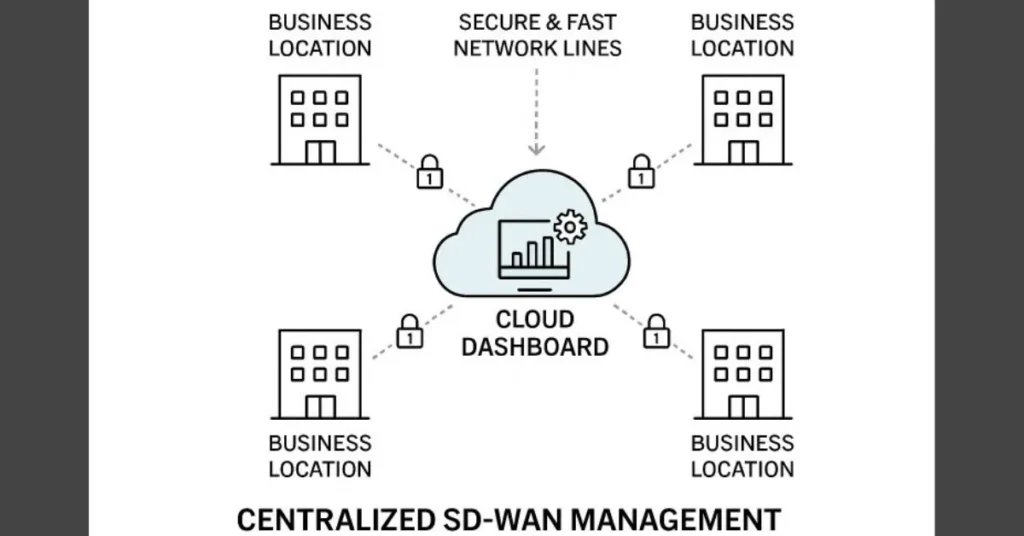Key Takeaways
- SD-WAN centralizes network management, reducing complexity and operational costs.
- It enhances network performance by intelligently routing traffic based on real-time conditions.
- Integrated security features in SD-WAN ensure consistent protection across all locations.
- SD-WAN’s scalability supports business growth without significant infrastructure changes.
Managing network connectivity across multiple offices, branches, or locations has historically posed a daunting challenge for many organizations. The need to maintain seamless connections, manage security, and coordinate changes across dispersed sites often resulted in ballooning costs and technical headaches. Manual configurations, limited visibility, and isolated troubleshooting processes were the norm. However, the arrival of Software-Defined Wide Area Networking (SD-WAN) has revolutionized this landscape, providing organizations with a smarter and simpler way to manage all their network needs. Cutting-edge solutions like Secure SD-WAN empower businesses with a centralized, cloud-managed platform that ensures robust, flexible, and secure connectivity, regardless of the number of locations added or the location of employees.
Unlike previous generations of WAN technology, SD-WAN doesn’t just reduce the technical friction involved in connecting remote sites; it actually enhances the underlying network by providing adaptive traffic control, integrated security, and seamless scalability. These capabilities are vital in today’s digital-first business environment, where agility and security are non-negotiable. By leveraging SD-WAN, IT teams can support large-scale digital transformation initiatives with confidence, knowing that every branch, regardless of its size or location, receives the same level of performance and protection. This positions SD-WAN as a foundational element in constructing a modern, adaptive enterprise network.
Contents
Centralized Network Management
The bedrock of SD-WAN’s value proposition is its ability to bring all network controls and visibility into a single, intuitive dashboard. Historically, network administrators had to physically travel to branch locations or configure routers and firewalls one-by-one—a painstaking and error-prone process. With SD-WAN, all connected endpoints, whether they number in the dozens or the hundreds, can be rapidly configured and managed from a unified control panel. Any change in policy—be it around application priorities, quality of service, or security enforcement—can be rolled out simultaneously network-wide, leaving no room for gaps or inconsistencies caused by manual intervention. Real-time monitoring tools provide IT teams with a comprehensive overview of network health and usage trends, ensuring that issues are identified and addressed before they impact business operations.
This level of centralization doesn’t just streamline operations—it drastically slashes the time and technical resources needed to onboard new sites or deploy new applications. Enterprises can expand into new regions, add pop-up branches, or shift company headquarters, all without the need for exhaustive manual setup. This agility, along with the resulting operational savings, makes SD-WAN a compelling choice for businesses with distributed footprints.
Intelligent Traffic Routing
One of the hallmarks of SD-WAN functionality lies in its dynamic, application-aware traffic routing. Instead of treating every data packet the same way, SD-WAN leverages constant real-time monitoring to assess network conditions, including factors such as available bandwidth, latency, jitter, and packet loss. It uses this information to intelligently select the best available connection for every type of traffic. For instance, business-critical tasks such as VoIP calls, video conferencing, or enterprise cloud applications are routed over the fastest, most reliable paths available, while non-essential background traffic can be shifted to lower-cost or secondary links.
Seamless User Experience
This sophisticated traffic management is what truly enables enterprises to offer a seamless digital experience to both their employees and customers. Downtime is minimized and service interruptions become rare, even during network outages or periods of unusually high demand. Rather than relying on fixed, manual failover policies, SD-WAN automatically reroutes traffic around bottlenecks or outages, maintaining performance for mission-critical activities. This level of responsiveness is especially crucial for organizations that leverage cloud-based services or support remote teams across different time zones and geographies.
Enhanced Security Measures
Security is a paramount concern in any networking decision, especially for organizations with distributed offices and remote workers. SD-WAN addresses this head-on by weaving advanced security protections directly into its architecture. As soon as new branches or endpoints are added, features like end-to-end encryption, next-generation firewalls, unified threat management, and intrusion prevention become instantly available and manageable from the central console. Application-layer filtering further ensures that only legitimate, sanctioned traffic moves through the network, reducing the attack surface and mitigating threats.
Enterprises operating under strict compliance requirements—such as HIPAA in healthcare or PCI DSS in retail—find SD-WAN particularly advantageous, as security policies can be enforced uniformly and auditable logs are generated for every network event. Changes in compliance mandates are easier to address, since policies can be updated across all sites instantly, keeping sensitive data secure and meeting privacy obligations everywhere the network reaches.
Scalability and Flexibility
SD-WAN stands out for its inherent scalability and adaptability, both of which are critical for modern organizations that need to pivot quickly. Traditional WAN expansions required significant investments in new hardware, reconfiguration of core settings, and lengthy, costly rollouts. In contrast, the software-defined, cloud-based approach of SD-WAN enables businesses to seamlessly add locations or increase capacity on the fly. Logical overlays—in effect, templates that carry all network and security settings—propagate instantly to new endpoints, enabling swift and secure onboarding of new branches or remote offices.
Adapting to Evolving Needs
As business requirements evolve—such as through mergers, acquisitions, seasonal expansions, or the rapid deployment of remote workforces—SD-WAN provides businesses the ability to flexibly scale up or down without the need for major capital investments or operational delays. This ensures that IT infrastructure is never a bottleneck for growth or migration projects, allowing organizations to remain nimble under changing conditions.
Cost Efficiency
One of the primary drivers for SD-WAN adoption is its remarkable cost efficiency, particularly compared to legacy WAN architectures that rely heavily on expensive, proprietary connections, such as MPLS. By enabling the use of affordable, high-speed broadband, LTE, and even 5G for branch networking, SD-WAN dramatically reduces both direct connectivity expenditures and ongoing maintenance costs. Businesses gain the flexibility to mix and match internet sources, optimizing for performance and budget, while enjoying the benefits of robust security and reliability.
Operational savings are not limited to network circuits alone: reduced travel for IT staff, lower support costs, quicker issue resolution, and fewer outages all contribute to a leaner IT budget. The resulting cost savings can then be reinvested in business innovation, digital transformation, or expanding the company’s technology footprint.
Conclusion
SD-WAN is rapidly redefining how organizations think about network design, management, and security—especially for businesses with multiple sites, branches, or remote workforces. With its centralized controls, smart routing, tightly integrated security features, and unparalleled scalability, SD-WAN delivers far more than just a faster or more reliable network. It empowers businesses to operate with unmatched agility, efficiency, and cost-effectiveness, setting the stage for meaningful digital transformation.

